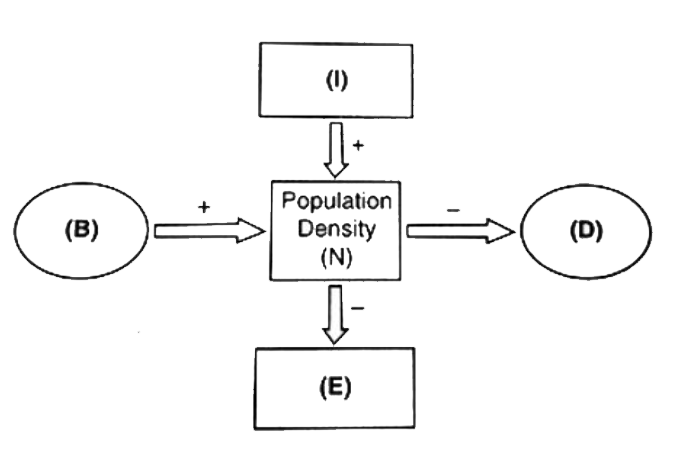(a) Study the flow chart given below and complete the equation that follows by identifying 1, 2, 3 and 4.

(b) Mention the different ways by which the population density of different species can be measured.
(a) Nt+1=Nt+{(1+2)−(3+4)}
Nt+1=Nt+{(B+I)−(D+E)}
Nt = Population density at time t
B = Natality
I = Immigration
D = Mortality
E = Emigration
Population density will increase if the number of births plus the number of immigrains (B+I) is more than the number of deaths plus the number of emigrants (D+E), otherwise it will decrease.
(b) Population density means, number of individuals present per unit area, population density can be measured by determining the population size, the different methods to study population density are as follows :
1 Percent cover biomass : In an area with 200 parthenium plants and only one banyan tree with large canopy, the density of banyan tree is small but does not reflect its important role in the community. Here, present cover or biomass is a more meaningful method of assessing population density.
Total Number : It involves physically, counting of organisms in the given area.
3. Relative Density : In this method there is no need to count the organisms individually.
Example : The number of fishes per trap gives the measure of their total density in a given water body.
4. Indirect Assessment : The tiger census is based on pug marks and foecal pellets.
Topper's Solved these Questions
- XII BOARDSBOOK - XII BOARD PREVIOUS YEAR PAPER ENGLISHCHAPTER - XII BOARDSEXERCISE - SET -I Section -A
8 Videos
- XII BOARDSBOOK - XII BOARD PREVIOUS YEAR PAPER ENGLISHCHAPTER - XII BOARDSEXERCISE - SET -I Section -B
11 Videos
- XII BOARDSBOOK - XII BOARD PREVIOUS YEAR PAPER ENGLISHCHAPTER - XII BOARDSEXERCISE - Section C
19 Videos
- SAMPLE PAPER 2019BOOK - XII BOARD PREVIOUS YEAR PAPER ENGLISHCHAPTER - SAMPLE PAPER 2019EXERCISE - Section E Part B
3 Videos
Similar Questions
Knowledge Check

Study the flow chart given below:
Which of the following statements is incorrect regarding this?AP can be root apical meristemwhich is generally sub-terminal in position.BQ can bephloem which is also called bast.CR can be parenchyma which comprises of thin walled isodiametric cells.DS can becollenchyma which is a living mechanical
Study the diagrams given below and answer the questions tht follow:

Name the cells labelled 1,2 and 3
View SolutionStudy the diagram given below and then answer the question that follow :

Name the parts labelled 1, 2, 3, 4, 5, and 6.
View SolutionStudy the diagram given below and then answer the questions that follow :

Name the parts labelled 1,2,3,4,5 and 6.
View SolutionStudy the diagrams given below and answer the questions tht follow:

Mention two structural differences between 1 and 2
View SolutionDifferent factors affecting population density are given below . I ,B ,D and E represent :

View Solution(a) List any three ways of measuring population density of a habitat.
(b) Mention the essential information that can be obtained by studying the population density of an organism.
View SolutionStudy the schematic representation given above and answer the following questions : (a)Identify A in it. (b)Identify D in it. (c)When the population density at time t is N as shown above, write the population density at time t+1 in the form of an equation using appropriate symbols.

View Solution


